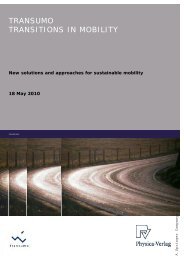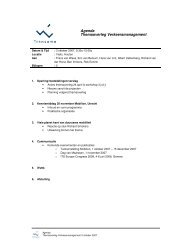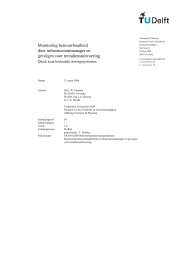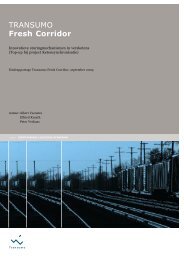Casestudie Breakdown prediction Contell PILOT - Transumo
Casestudie Breakdown prediction Contell PILOT - Transumo
Casestudie Breakdown prediction Contell PILOT - Transumo
You also want an ePaper? Increase the reach of your titles
YUMPU automatically turns print PDFs into web optimized ePapers that Google loves.
⎛ 1<br />
⎜<br />
⎜1−<br />
p<br />
⎜ 0<br />
P = ⎜<br />
⎜ 0<br />
⎜<br />
⎜<br />
0<br />
⎝ 0<br />
0<br />
0<br />
1−<br />
p<br />
0<br />
0<br />
0<br />
0<br />
p<br />
0<br />
1−<br />
p<br />
0<br />
0<br />
0<br />
0<br />
p<br />
0<br />
1−<br />
p<br />
0<br />
0<br />
0<br />
0<br />
p<br />
0<br />
0<br />
0<br />
0<br />
0<br />
0<br />
p<br />
1<br />
⎞<br />
⎟<br />
⎟<br />
⎟<br />
⎟<br />
⎟<br />
⎟<br />
⎟<br />
⎠<br />
Formula 5-14: Sample Transition Probability Matrix<br />
Figure 5-5: Sample Transition Probability Graph<br />
Up to now, the transition probability matrix only made it possible to obtain the<br />
probability for a single change. But also important are probabilities of several<br />
changes in a row, as pictured in Formula 5-15. ([Beichelt97], p. 147)<br />
p<br />
( m)<br />
ij<br />
= P(<br />
X<br />
+<br />
= j | X = i)<br />
m = 1,2,...<br />
n<br />
m<br />
n<br />
Formula 5-15: Transition Probabilities of Several Changes in a Row<br />
(m)<br />
p<br />
ij<br />
symbolizes the probability that state i will change to state j after m steps.<br />
Apparently,<br />
p = is complied. The calculation of m > 1 can be done by using the<br />
(1)<br />
ij<br />
p ij<br />
formula of Chapman-Kolmogorov, which is pictured in Formula 5-16. ([Beichelt97], p.<br />
147)<br />
m<br />
( r ) ( m−r<br />
)<br />
pij = ∑ pik<br />
pkj<br />
r = 1,2, K , m −1<br />
k∈I<br />
Formula 5-16: Formula of Chapman-Kolmogorov<br />
Using the knowledge that one state of the countable state space has to be taken<br />
after r steps in combination with the knowledge of the total probability and the<br />
Markov property leads to an easy argumentation. 54 As a result the transition<br />
probability matrix for r steps is determined by multiplying r times the matrix by itself.<br />
This enables a simplified version of Formula 5-16. ([Beichelt97], p. 148)<br />
54 See ([Beichelt97], p. 147) for details<br />
70
















